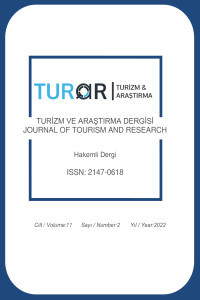KONAKLAMA SEKTÖRÜ ÇALIŞANLARININ ÖRGÜTSEL BAĞLILIĞI: VAN ÖRNEĞİ ORGANIZATIONAL COMMITMENT OF HOSPITALITY SECTOR EMPLOYEES: VAN EXAMPLE
Van İlinde yer alan konaklama işletmelerinde görevli çalışanların örgütsel bağlılıkları ile
demografik farklılıkları arasındaki ilişkinin incelenmesi amaçlanmaktadır. Çalışma 2017’de, Van
Merkezinde bulunan 55 konaklama işletmesinde yürütülmüştür. Örneklemde çalışmaya katılan 257
gönüllü kişi yer almaktadır. Araştırmanın anket formu iki bölümden oluşmaktadır. Demografik
sorulardan oluşan birinci bölümde, örneklem grubundaki işletmelerin ve işletme yöneticilerinin
temel özelliklerinin ortaya çıkarılması hedeflenirken, ikinci bölümde örgütsel bağlılık ölçeğine
ilişkin 22 soru yer almıştır. Araştırmada 7 temel hipotez kurulmuştur. Bunlar; çalışanların cinsiyet,
medeni durum, yaş, eğitim durumu, gelir durumu, işletmede çalışma süresi ve şu an ki işletmede
çalışma süresine ilişkin hipotezlerdir. Anket sonucunda elde edilen veriler SPSS yazılımı ile analiz
edilmiştir. Araştırmada veri toplama aracı olarak örgütsel bağlılık anketi de çalışanlara
yöneltilmiştir Allen and Meyer (1990) üç boyutlu örgütsel bağlılık modeli esas alınmış, Wasti
(2002) tarafından geliştirilen örgütsel bağlılık ölçeği kullanılmıştır. Araştırmada kullanılan 7
hipotezden, cinsiyet ve medeni durumuna göre anlamlı bir farklılık görülmemiştir. Fakat yaş ve
eğitimde normatif bağlılık boyutunda, gelir ve turizm sektöründe çalışma yılında devam ve normatif
bağlılık boyutunda anlamlı farklılık olduğu görülmüştür. Ayrıca şu an ki iş yerinde çalışma yılına
göre de, örgütsel bağlılık düzeyi yüksek olduğu ortaya çıkmıştır.
Therelation ship between organizational commitment and demographic differences of employees
working in accommodation businesses in Van Province is aimed. The study was conducted in 55
accommodation establishments in Van Center in 2017. The sample includes 257 people who
participated in the research. The survey form of there search consists of two parts. In the first place
among the demographic questions, it was aimed to reveal the main characteristics of the enterprises
and businessmanagers in the sample group, while the coloring 22 questions were replaced in the
second organizational commitmentscale. 7 basichypo these shave been established in there search.
These; Employees' gender, maritalstatus, age, educationalstatus, income, working time in the
business, and working time in a current business are hypotheses. The data obtained from the
question naire were analyzed with SPSS software. Intheresearch, the organizational commitment
question naire was directed to the employees as the data collection tool. Allenand Meyer's (1990)
three – dimensional organizational commitment model was taken as the basis, the organizational
commitment scalerepeated by Wasti (2002) wasused. Of the 7 hypothesesused in the study, nome
aningful was know naccording to genderandmarital status. However, it has been observed that it is
seen in the dimension of normative in ageandeducation, in the dimension of continuation,
andnormative in income and tourism study area. Itwasal sorevealed thatthe level of organizational
commitment is higherthanthecurrent work place.
___
- Agarwala, Tanuja, Amaia Arizkuren-Eleta, Elsa Del Castillo, Marta Muniz-Ferrer and Leire Gartzia
(2014) “Influence of Managerial Support on Work–Life Conflict and Organizational
Commitment: An International Comparison for India, Peru and Spain”, The International of
Human Resource Management, 25 (10): 1460-1483.
- Affum-Osei, E., Acquaah, E., & Acheampong, P. (2015). Relationship between organisational
commitment and demographic variables: Evidence from a commercial bank in Ghana.
American Journal of Industrial and Business Management, 5(12), 769.
